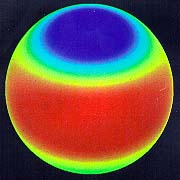
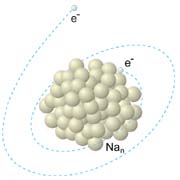
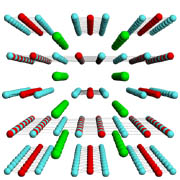
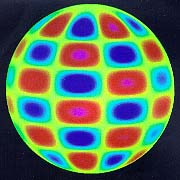

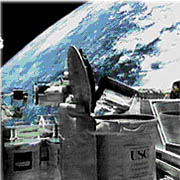

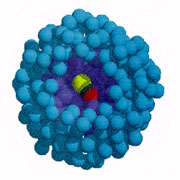
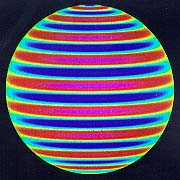
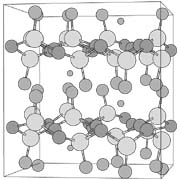
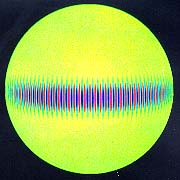
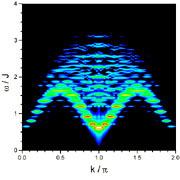
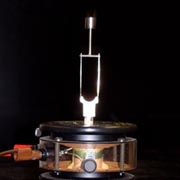

|
The following images and text are a complete summary of the
Research Highlight images which cycle through the main
departmental page.
| |

| Helioseismology analyses the millions of standing acoustic waves of the sun (p modes). The picture shows a single spherical harmonic mode with l=2 and m=0. Colors represent the Doppler shifts seen from Earth. This is work from Prof. Dappen and coworkers. |

| Metallic clusters and nanoparticles are highly polarizable, which gives rise to strong long-range forces. Prof. Kresin and his group are using beam techniques to study the interaction of alkali clusters with slow electrons. For example, an electron can become captured by its own image charge and spiral into the cluster. These phenomena raise interesting questions concerning electron relaxation in size-quantized systems. |

| [Sr,Ca]14Cu24O41 is the first cuprate superconductor containing only quasi-one-dimensional components, such as CuO2 chains and Cu2 03 ladders. Prof. Haas has contributed to the development of a simple model based on Coulomb interactions for this compound. |

| Helioseismology analyses the millions of standing acoustic waves of the sun (p modes). The picture shows a single spherical harmonic mode with l=10 and m=5. Colors represent the Doppler shifts seen from Earth. This is work from Prof. Dappen and coworkers. |

| An embellished image of the equipotential lines of the "two-wire" electric deflection field used by the group of Prof. Kresin to measure the polarizabilities of metallic nanoclusters. |

| View of Space Shuttle Discovery's bay with the Solar Extreme Ultraviolet Hitchhiker-3 (SEH-3) at work. This is work of Prof. Judge and collaborators at the USC Space Sciences Center. |

| Impurities in the high-temperature superconductors strongly affect their thermodynamic and transport properties. Recent scanning tunneling microscope studies of Zn-doped Bi2Sr2CaCu2O8 have provided high-resolution images of the local density of states around Zn and Ni impurities. Prof. Haas and Prof. Maki have calculated the corresponding spinor wave functions of bound states at small energies centered around the impurity sites from the Bogoliubov-de Gennes equations for d-wave superconductors. |

| High pressure expansion of helium gas out of a micron-sized cryogenic nozzle into vacuum produces a jet of very cold, superfluid helium clusters. Prof. Kresin and coworkers are investigating the behavior of atoms and molecules trapped inside these flying "nanoscale cryostats." |

| Helioseismology analyses the millions of standing acoustic waves of the sun (p modes). The picture shows a single spherical harmonic mode with l=20 and m=0. Colors represent the Doppler shifts seen from Earth. This is work from Prof. Dappen and coworkers. |

| CaV4O9 (Calcium-Vanadium-Oxide) is a quantum spin liquid in which groups of four Vanadium spins are bound into plaquette resonant valence bond states. What happens when some of these spins are replaced by static vacancies or mobile holes? Using numerical techniques such as Monte Carlo simulations and Exact Diagonalizations, Stefan Wessel and Prof. Haas are exploring the various phases which may emerge. |

| Helioseismology analyses the millions of standing acoustic waves of the sun (p modes). The picture shows a single spherical harmonic mode with l=100 and m=100. Colors represent the Doppler shifts seen from Earth. This is work from Prof. Dappen and coworkers. |

| Spin-Peierls compounds, such as CuGeO3, have a gapped excitation spectrum with a dominant low-frequency boundstate, separated from a continuum of states at higher energies. Using a novel numerical renormalization group technique, Weiqiang Yu and Prof. Haas have calculated the dynamical structure factor for this system, which can be measured by inelastic neutron scattering experiments. |

| Inverted Pendulum as part of a Chaos experiment developed by Prof. Bergmann for Senior Laboratory course. When driven at ten times the resonant frequency and at sufficient amplitude, the pendulum bob will oscillate in the inverted position above the pivot point (as shown). By approaching a critical amplitude from above, the oscillation frequency in the inverted position approaches zero, like the critical slow down in a second order phase transition. |
